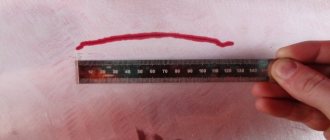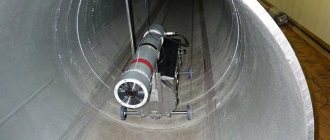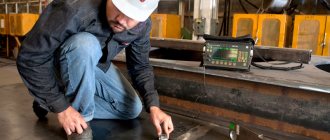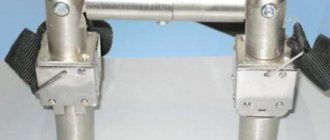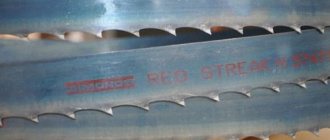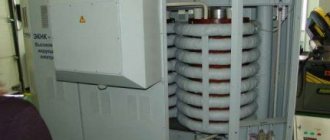Radiography of welded joints is a non-destructive testing method. Radiographic testing is designed to detect in welded joints:
- lack of penetration;
- cracks;
- various inclusions;
- since then.
The method is also used to assess the amount of concavity and convexity of the root of the seam, to identify undercuts and burns that are inaccessible for visual inspection.
The essence of the method
The radiography method involves obtaining a shadow image of a welded joint by illuminating it with X-ray or gamma radiation. The goal is to study the internal structure of the control object.
The special properties of X-ray and gamma radiation are associated with their different absorption and penetration when passing through different media, depending on the type of material, its thickness and radiation energy. These properties are used in flaw detection of welded products.
The essence of the radiography method is the phenomenon of blackening of the X-ray film emulsion, caused by the property of radiation that is of an electromagnetic nature. The degree of blackening of a particular area of the film after its photoprocessing depends on the number of photons, which is determined by the attenuating ability of the sample being illuminated.
Radiographic images obtained as a result of radiography, depending on the method of transillumination, are called:
- radiograph (x-ray radiation);
- gammagram (gamma radiation).
The shadow pattern visible in the image is the distribution of the attenuation power of the compound exposed to transillumination.
Advantages of the method:
- high sensitivity , allowing to detect minor defects;
- objectivity of the results obtained;
- the ability to determine the depth of the defect and its linear dimensions.
Flaws:
- low control performance;
- high consumption of reagents and film.
Radiography of a weld: what it reveals and how it is done
Radiography is a non-destructive testing method that allows you to determine the presence of internal defects in the base metal. This is the most accurate and objective study, thanks to which the quality of the seams of metal structures and parts is confirmed. Radiographic testing consists of the following: X-ray radiation is directed at the connection being tested, and on the reverse side there is a film sensitive to X-ray rays. Various weld defects absorb rays worse than homogeneous metal, appearing on the film in the form of light spots. The shape and size of welding defects are judged by their outlines and sizes.
GOST
Requirements for the quality of joints formed by welding are specified in regulatory and technical documents. The radiographic method of non-destructive testing of welded joints is regulated by GOST 7512-82 “Non-destructive testing. Welded connections. Radiographic method".
The document contains:
- General provisions.
- equipment requirements.
- Information regarding preparation for control.
- Control circuits.
- Selecting radiography parameters.
- Decoding images.
- Safety regulations.
- Metrological support.
GOST has 6 annexes.
GENERAL PROVISIONS
1.1. Radiographic testing is used to detect cracks, lack of penetration, pores, slag, tungsten, oxide and other inclusions in welded joints.
1.2. Radiographic testing is also used to identify burns, undercuts, and assess the magnitude of convexity and concavity of the root of the seam, which are unacceptable for external inspection.
1.3. Radiographic monitoring does not reveal:
- any discontinuities and inclusions with a size in the direction of transmission of less than twice the control sensitivity;
- lack of penetration and cracks, the opening plane of which does not coincide with the direction of transmission and (or) the opening value is less than the values given in the table. ;
- any discontinuities and inclusions, if their images in the photographs coincide with the images of foreign parts, sharp corners or sharp changes in cracks of the metal being scanned.
1.1 — 1.3. (Changed edition, Amendment No. 1).
Table 1
mm
| Radiation thickness (according to GOST 24034) | Opening of lack of penetration (cracks) |
| Up to 40 | 0,1 |
| St. 40 » 100 incl. | 0,2 |
| » 100 » 150 » | 0,3 |
| » 150 » 200 » | 0,4 |
| » 200 | 0,5 |
1.4. Radiographic testing is carried out on welded joints with a ratio of the radiation thickness of the deposited weld metal to the total radiation thickness of at least 0.2, which have two-way access, allowing the installation of a cassette with radiographic film and a radiation source in accordance with the requirements of this standard.
Required equipment
Depending on the method, different types of equipment are used.
X-ray machines
To obtain an x-ray, the following equipment is required:
- x-ray machine;
- defectometer.
Device design:
- x-ray tube;
- high voltage generator;
- Remote Control.
Gamma devices
The device is a radioisotope flaw detector consisting of the following elements:
- radiation head with radioactive isotope;
- power supply drive;
- ampoule tube;
- Remote Control.
Gamma control is performed using artificial radioactive isotopes iridium 192, thulium 170, cobalt 60. The isotopes are stored in special containers.
Advantages compared to the X-ray method:
- the container with the isotope is small in size , which does not require much space for its placement and is convenient for field conditions;
- Gamma rays allow simultaneous monitoring of several parts;
- The method is applicable to obtain a gammagram of a circumferential weld of a welded product;
- the costs of carrying out are lower than the x-ray method;
- The service life of the drug cobalt 60 is more than 5 years.
The disadvantage of the method is that the sensitivity to detecting defects in seams less than 50 mm thick is lower than when using an X-ray machine.
Other equipment
When inspecting products with a cross section of 70 mm or more in radiation flaw detection, linear accelerators, betatrons and microtrons are used.
Auxiliary elements:
- Radiographic film is a means of recording radiation.
- Reinforcing fluorescent and metal screens - to reduce transillumination time.
- Sensitivity standards - determination of the relative sensitivity of radiographic control.
- Cassettes, holders, lead markings.
Radiographic testing of welded joints
Since the development of the first methods of connecting elements using welding technologies, the question of monitoring the quality of welding seams has arisen. Taking into account existing technologies, designers have developed various methods that provide fairly accurate detection of structural defects that threaten destruction. However, a universal method that can satisfy the needs of production workers does not yet exist. Therefore, today, when performing welding work, production workers are forced to choose the most suitable control methods that satisfy them:
• A cheaper and simpler process, without the use of complex equipment, capable of providing a satisfactory assessment of the quality of the weld. • A rather complex and expensive method, used only in production that has the technological capabilities, while showing an objective and complete picture.
Accurate flaw detection options have to be used in such circumstances when the quality of the seam is of key importance and even insignificant defects are unacceptable. Namely, radiographic testing of the quality of welded joints satisfies such requirements.
The proposed method of radiographic inspection of welds, based on the properties of the transmission of the inspected area with gamma rays or X-rays, is one of the most accurate.
At the same time, industrial radiography is a profession that is one of the most harmful to human health. The method uses powerful gamma sources (> 2 CI).
Radiographic testing equipment
Inspection can be performed using industrial X-ray equipment, gamma flaw detectors.
The choice of the required radiation source is influenced by the thickness of the material, as well as the given geometry class and transmission sensitivity.
X-ray flaw detectors
The advantages of stable radiation X-ray flaw detectors include:
- Higher power.
- Ability to adjust.
- Durability.
- Clear and contrasting image.
The disadvantage of X-ray flaw detectors is their high cost, large size and danger for workers.
Gamma flaw detectors
Despite the fact that it is recommended to check welding seams using X-ray equipment, which, in comparison with gamma flaw detectors, creates higher-quality radiographic images, gamma flaw detectors also have a number of advantages, namely:
- Low cost.
- Small in size.
- Small optical focus.
The main disadvantage of this equipment is the lack of ability to adjust the power, poor contrast, slow attenuation of the source radiation and the need to replace it.
Gamma flaw detectors, as a rule, are used when it is not possible to use continuous X-ray equipment (when testing products of small thickness, if there are no power sources, when testing hard-to-reach areas).
Carrying out radiographic testing
The essence of the process, regulated by GOST (om) 7512-86, is to illuminate the area being tested with gamma rays or x-rays from a source placed in a special protective capsule. Namely, the capsule provides protection from the harmful effects of rays on equipment and personnel located nearby. Since homogeneous metal absorbs rays better than voids that disrupt the structure of the material, defective areas are indicated by light spots, with a shape and size corresponding to the shape and size of the detected flaws (cracks, voids, slag, etc.). At the same time, recording flaw detection readings can be carried out in various ways.
On paper or film, with the surface coated with a chemical layer of a radiation-sensitive element. The proposed method for recording flaw detection data is accurate, but reduces the speed of the study. It has proven itself well in the production of limited quantities of high-quality products.
Using special substances called “scintillators”, which are capable of absorbing rays invisible to the eye, converting them into visible light. Using such a converter, the resulting image is displayed on the monitor, providing flaw detection of the weld in real time. This technique is suitable for mass production, and is also used to test welds in pipelines being installed and repaired. Here, a capsule containing harmful radiation is usually placed inside the pipeline, providing high-quality control.
To obtain reliable radiographic testing data, certain conditions must be met.
- It is necessary to remove scale, slag and other contaminants from the surface of the weld being tested that may affect the actual picture.
- The density of the emitted flux must be such that recording the thickness of the area being tested becomes possible.
- During the entire period of the study, the ray density should be stable.
- Technological maps for each controlled area are developed in accordance with GOST (a) regulations.
The characteristics of the emitted source are selected depending on the product being tested and its thickness. Correct results will be obtained only if the listed requirements are met. Safety during radiographic testing
When using radiographic inspection techniques for welding joints, the most important problem is ensuring safety measures.
To prevent the spread of radiation, the equipment on which personnel work must be reliably shielded. Lead sheets can be used to provide this protection. At the same time, today's industry also produces other materials from plastics or fabrics. The main thing is that the protective materials are airtight and clearly fulfill their purpose.
The operator carrying out the control must be removed from the equipment at the maximum possible distance, and when checking, there should be no unauthorized persons nearby.
If there is an urgent need for people to be in a dangerous area during the operation of the equipment, the personnel must be provided with personal protective equipment. At the same time, it is necessary to minimize the time people spend in the control zone, since even small doses of radiation accumulate over time, negatively affecting human health.
When working with radioactive substances, it is necessary to organize their safe storage, as well as delivery to the workplace.
You cannot work on equipment that is known to be faulty. This may distort not only flaw detection indicators, but also the health of both working personnel and third parties may be at risk. The radiation accumulated in the product can negatively affect people who happen to be nearby.

